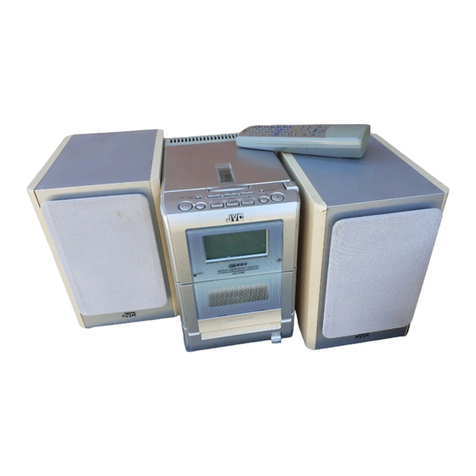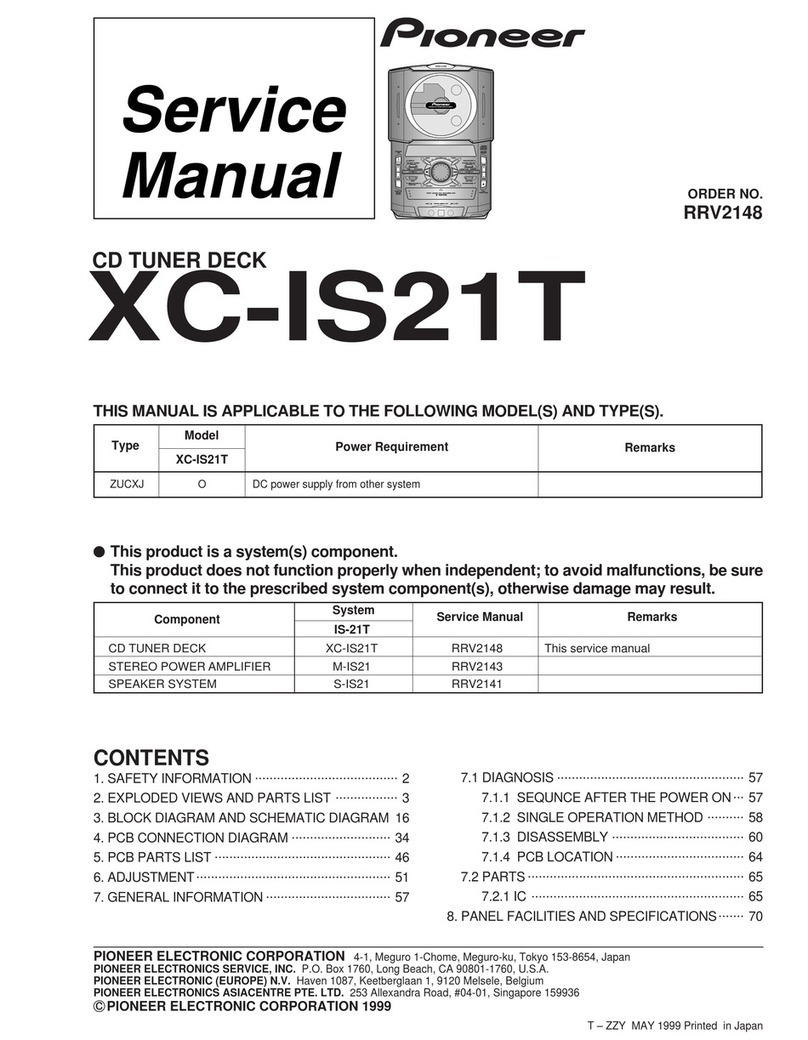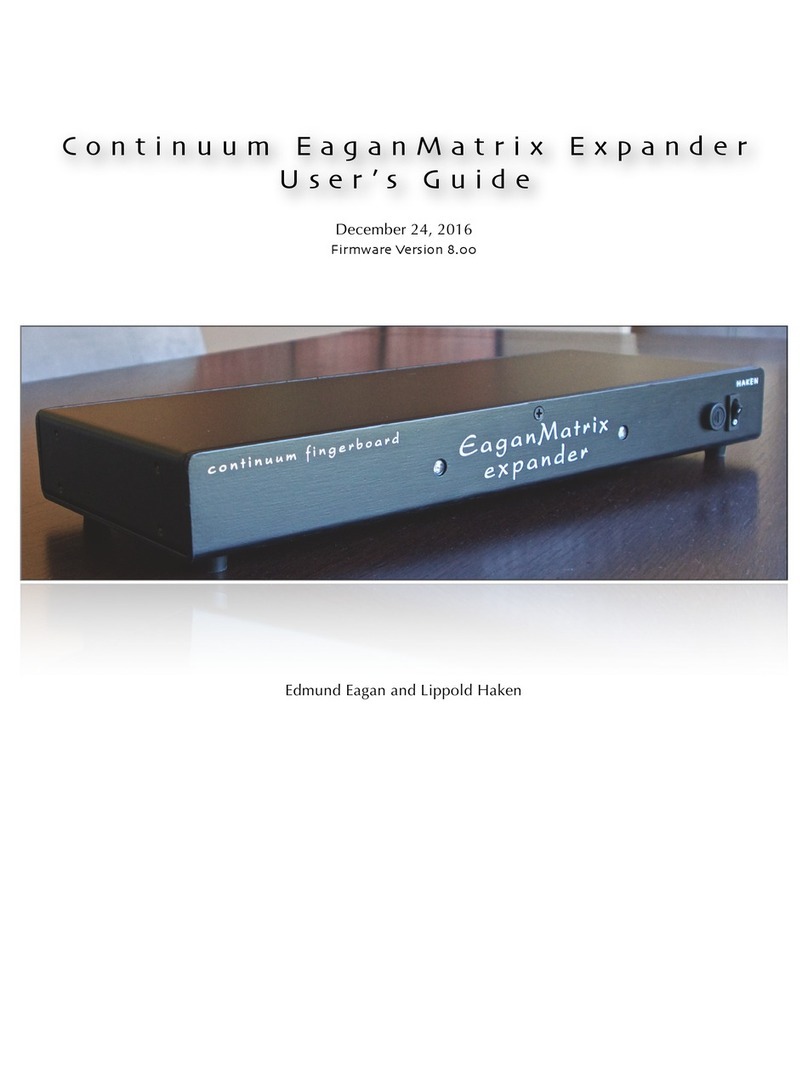CBS AUDIMAX III Manual

~-
DO
AUDIMAX®
III
AUDIMAX®
III
S
Automatic
level
control
OPERATI
NG
AND
MAl
NTENANCE
I
NSTRUCTI
ONS

AUDIMAX
®
III
AUDIMAX
®
III S
Automatic level control
OPERATING AND MAINTENANCE INSTRUCTIONS
May, 1967
Transcribed uly 2011
By Robert W. Meister WA1MIK
New Figures September 2011
Reorganized October 2011

i
TABLE OF CONTENTS
SECTION I - INTRODUCTION 1
1-1 GENERAL 1
1-2 WARRANTY 1
1-3 FACTORY SERVICE AND REPAIR 1
1-4 SPECIFICATIONS 2
SECTION II - INSTALLATION PROCEDURES 3
2-1 UNPACKING 3
2-2 PHYSICAL INSTALLATION 3
2-3 ELECTRICAL INSTALLATION 3
2-4 ELECTRICAL CONNECTIONS 3
SECTION III - SETUP PROCEDURE 4
3-1 LEVEL AD USTMENT 4
3-2 VARIATIONS FROM STANDARD OPERATING PROCEDURES 4
3-3 GATED GAIN STABILIZER 4
3-4 FUNCTION SWITCH 5
3-5 LIMITED DYNAMIC RANGE APPLICATIONS 5
3-6 STEREOPHONIC OPERATION 6
SECTION IV - THEORY OF OPERATION 7
4-1 GENERAL 7
4-2 CIRCUIT OPERATION 9
4-3 GATED GAIN STABILIZATION 11
4-4 FUNCTION SWITCH AND METER 11
4-5 STEREOPHONIC ADAPTER 12
SECTION V - MAINTENANCE 18
5-1 GENERAL 18
5-2 SERVICING THE MAIN AMPLIFIER 18
5-3 SERVICING THE GATED GAIN STABILIZER 19
5-4 SERVICING THE LOGIC BOARD AND MEMORY UNIT 19
5-5 TRANSIENT PERFORMANCE 20
5-6 BULB REPLACEMENT 20
5-7 CIRCUIT BOARD INTERCONNECTIONS 21
SECTION VI - PARTS LIST 22
6-1 AUDIMAX III 22
6-2 STEREOPHONIC ADAPTER 28
ILLUSTRATIONS
FRONTISPIECE ii
4-1 AUDIMAX III BLOCK DIAGRAM 8
4-2 FUNCTIONAL DIAGRAM 10
4-3 STEREOPHONIC ADAPTER SCHEMATIC DIAGRAM 13
4-4 AUDIMAX III S/N 101 THROUGH 200, SCHEMATIC DIAGRAM 14
4-5 AUDIMAX III S/N 201 AND ABOVE, SCHEMATIC DIAGRAM 16

ii
•
AUDIMAX III, MODEL 444
.
'.--'.---.
~
-.(.
'
"..
.
~
''''',
Efl
,;:
--
'''-''h
AUDIMAX III
S,
MODEL 445

1
SECTION I
INTRODUCTION
1-1 GENERAL
The new solid-state Audimax
®
III, Model 444, like its companion piece, Volumax
TM
, is a tool to
help the broadcaster achieve maximum program power within appropriate modulation limits.
Incorporating all of the features of its famous predecessor, the Audimax III also provides
additional gain and versatility. Designed for use wherever high quality automatic gain riding is
required, Audimax III offers a unique method of audio control for AM, FM, and TV broadcasting,
recording, motion pictures and public address use.
Audimax III is the latest development in the unique Audimax system of audio control developed
by CBS Laboratories. Applicable to all audio media, the Audimax is totally different in concept
from ordinary compressors, limiters or AGCs. The Audimax acts like a highly capable studio
technician, but without many human limitations. Valuable in the studio, the Audimax is often
more reliable outside, away from controlled studio conditions. The ability of the Audimax to act
instantly and control audio levels intelligently frees engineers to cope with the may other
problems of remote pick-ups.
The new solid-state Audimax III offers the ultimate in automated gain control combined with the
extreme reliability of solid-state circuitry. The exclusive GAIN PLATFORM principle permits gain
to remain on a stable plateau over a wide range of input levels rather than continuously allowing
it to rise and fall with consequent distortion, thumping and pumping, and audio "holes". The
unique GATED GAIN STABILIZER acts to bridge through program lapses and thus eliminates
“swish-up” of background noise. A special RETURN-TO-ZERO function returns gain to normal
during standby conditions.
1-2 WARRANTY
A warranty, with a return post card is included with your Audimax III. Fill out the post card and
return it to CBS Laboratories as soon as possible to validate your warranty.
1-3 FACTORY SERVICE AND REPAIR
If you should experience difficulty in installing, operating, or repairing Audimax III, please contact
CBS Laboratories, Professional Products, Stamford, Connecticut (Area Code 203) 327-2000. (In
1986, the CBS Technology Center in Stamford ceased operation; they stopped making these
units long before then.)

2
1-4 SPECIFICATIONS
AUDIMAX III, Model 444
Frequency Response Flat within 1 dB from 50 Hz to 15,000 Hz
Harmonic Distortion Below 1% from 50 Hz to 15,000 Hz at +16 dBm output
Noise Level Below -60 dBm output, with NORMAL gain
Control Characteristic ±10 dB of gain control
Gated Gain Stabilization Threshold adjustable from -20 dB to normal input
Maximum Gain 50 dB (See Note below)
Input and Output Impedance 600 ohms, balanced or unbalanced (150 ohms on
special order)
Minimum Input Level -30 vu (See Note below)
Normal Output Level +11 vu
Maximum Output +25 dBm
Maximum Operating Temperature 55°C
Physical Dimensions Standard 19" rack mounting, 3-1/2" high, 9-5/8" deep
Power Requirements 15 watts at 115/230 volts ac, 50-60 Hz
AUDIMAX IIIS, Model 445, (Stereo)
Physical Dimensions: Standard 19" rack mounting, 7" high, 9-5/8" deep
Power Requirements 30 watts at 115/230 volts ac, 50-60 Hz
NOTE: As delivered, Audimax III contains a 20 dB fixed attenuator in the input circuit. Removal
of this pad will permit user to realize specified maximum gain and minimum input level.

3
SECTION II
INSTALLATION PROCEDURES
2-1 UNPACKING
Carefully unpack your Audimax III and examine the unit for any evidence of physical damage
that may have occurred during shipment. In the event of damage file a claim immediately with
the carrier. If future transportation of the unit is anticipated, save the shipping carton for reuse.
2-2 PHYSICAL INSTALLATION
Audimax III is designed to be mounted in a standard 19-inch-wide rack. The unit requires 3-1/2-
inch-high front panel space and is slightly less than 10 inches deep. Install the unit in a
reasonably well-ventilated position making certain that there is no high heat producing
equipment beneath it. The ambient temperature should not exceed 130°F.
2-3 ELECTRICAL INSTALLATION
The Audimax III power supply is equipped with a power transformer permitting the selection of
either 115-volt or 230-volt operation. If 230-volt operation is required, remove the jumper on the
power supply board from lugs 1 to 2 and 3 to 4. Reconnect a single jumper between lugs 2 and
3. Replace the fuse with a type 3AG-0.15 amp fuse.
For broadcast applications, it is recommended that the Audimax III be installed at a studio or
console and its output fed directly into the main audio line. Satisfactory operation requires that
the unit be presented with a constant 600/150-ohm impedance throughout the audio band.
A fast acting peak limiter is recommended for use at the transmitter (following Audimax III).
However, this peak limiter should be set to show only occasional limiting of 2 or 3 dB. For best
results, a CBS Laboratories' Volumax should be used instead of a conventional peak limiter.
NOTE
The master volume indicator should follow Audimax III.
This will discourage unnecessary gain riding which might
tend to defeat the automatic features of Audimax.
2-4 ELECTRICAL CONNECTIONS
Input and output leads should be connected to the five-terminal strip at the rear of the chassis.
Terminals 1 and 2 are the input, and terminals 4 and 5 are the output connections. The unit may
be connected for balanced or unbalanced operation. Terminal 3 is the chassis ground. The
standard Audimax III is delivered for 600-ohm operation. For 150-ohm operation special input
and output pads may be installed and transformers T2 and T3 strapped as shown on the
schematic diagram (see Figure 4.4 and 4.5). The fixed attenuator at the input terminals must
also be removed or converted for 150-ohm operation.

4
SECTION III
SETUP PROCEDURE
3-1 LEVEL AD USTMENT
Audimax III is supplied with a 20 dB fixed pad at its input to accommodate the levels usually
present at the output of consoles. The minimum input for full automatic control is -10 vu under
these conditions. However, removal of this pad permits normal operation with input levels as low
as -30 vu.
With proper input levels, average program material should cause the front panel meter to
indicate approximately 0 dB gain (this figure is relative and does not refer to actual gain of the
amplifier). In this way, the advantage of ±10 dB of level correction can be realized.
The INPUT LEVEL setting may be established by either of two methods:
a. Use a recording or other program source and adjust the INPUT LEVEL control, as
indicated above, until the average "0 dB" reading is achieved.
b. An oscillator may be used in place of the usual program sources or connected directly to
the Audimax III input. The oscillator output (at 1 kHz) should be adjusted so as to result in
a level 4 dB higher than the normal vu level of the line in which Audimax III is connected.
The INPUT LEVEL control is then adjusted for the "0 dB" reading. When an oscillator is
connected directly to the Audimax III, it is important that proper impedance matching be
observed and that no other loads are present on the line.
The OUTPUT LEVEL control is continuously variable over a 30 dB range to provide a maximum
of 11 vu with normal program input.
3-2 VARIATIONS FROM STANDARD OPERATING PROCEDURES
Three variations from standard operating procedures should be observed when Audimax III is
used:
a. If the master volume indicator is properly installed at the Audimax III output, there will be
little tendency for manual gain control at this point. In fact, the rule here should be
"DON'T TOUCH!"
b. At individual stations, however, where an Audimax III is in control, it may be desirable at
times to readjust levels slightly. This should be done slowly, whether the program level is
too low or too high.
c. A third change of procedure concerns "fades". Since Audimax III will defeat any slow
deliberate reduction of level, all fades must be made more quickly than by usual
methods. A little practice will easily result in the required skill. The most convenient way
to insure proper procedures at all locations is to connect all cue lines to some point
beyond the Audimax III output.
3-3 GATED GAIN STABILIZER
The function of the Gated Gain Stabilizer (GGS) is to make the following decisions: Should the
gain be increased when a lapse occurs in the audio? This is especially important for television
and motion pictures where these lapses occur quite often. To prevent level increases of system

5
noise or audio signals, which are clearly background effects, the GGS inhibits gain "recovery"
during those intervals when the input level drops below a preset threshold.
The GGS threshold has been factory set to inhibit gain increase when the incoming signal has
dropped approximately 14 dB below the normal line level. This figure has been established after
extensive field experience, and represents a satisfactory value for typical broadcast use. For
special applications the GGS threshold may be move upwards towards normal program level by
decreasing the value of R45A or lowered by increasing the value of this resistor. The following
table gives suggested values:
GGS Threshold
R45A
-4 dB
120 ohms
-8 dB
220 ohms
-11 dB
430 ohms
-14 dB
680 ohms
-17 dB
2.4 k
-20 dB
open
Sine wave verification of the GGS threshold level may be accomplished by the following
procedure:
a. Feed a sine wave input to cause the front panel meter to read 0 dB gain reduction.
b. Remove the signal and wait at least 15 seconds for full stabilization to occur.
c. Reapply the input signal at a level below the required threshold and slowly increase the
signal until the front panel meter just begins to deflect towards the right. The input level at
this time should be approximately 5 dB less than that indicated by the above table. (This
5 dB difference is a special factor and must be considered when sine-wave calibration of
the GGS threshold is performed.)
3-4 FUNCTION SWITCH
Audimax III is in operation performing automatic level control when the FUNCTION switch is at
NORMAL position. Turning the switch to the TEST position causes the gain to hold constant at
the same level as for normal operation. The function of the TEST position is to provide for
overall system performance measurements.
3-5 LIMITED DYNAMIC RANGE APPLICATIONS
The gain control action of the Audimax has been designed to provide a precise degree of control
with a minimum of noticeable change in the original dynamic range. As a tool for the
broadcaster, it provides maximum modulation consistent with artistically acceptable
performance for a wide variety of program material. In some applications, however, it is practical
and desirable to further limit program dynamic range. This is commonly done for the purpose of
achieving higher average modulation, or a more uniform sound as in the case of public address
systems. This effect may be achieved by decreasing the Audimax recovery time.
Although the total gain-reduction action of the Audimax is a complex function of many variables,
one phase of the recovery characteristic may be modified by changing R76. This normally is a
10 megohm resistor mounted on lugs on the Logic Board. By decreasing its value, the speed of
recovery is increased. Typically, the resistance may be decreased to 5 megohms, although
values as low as 1 megohm can be used in special applications.

6
3-6 STEREOPHONIC OPERATION
For two-channel stereophonic operation, two Audimax III units are coupled together by means of
a stereophonic adapter board mounted in the upper chassis. The adapter employs resistive
mixing of the left and right Audimax III output signals and controls each of the two Audimax IIIS
with a signal proportional to the sum of left plus right. In this way, gain changes in both channels
are identical, thus preserving the stereophonic perspective, as well as making the system
responsive to the true volume level.
NOTE
The Monaural Audimax III units cannot be modified for
stereophonic operation in the field. If you anticipate going
to stereo operation in the future, CBS Laboratories
recommends the use of the Audimax IIIS, which can be
operated in a monaural mode until the changeover.
In the event that the incoming left and right channels are improperly phased with respect to each
other, the coupling circuitry in the stereophonic adapter would provide a difference signal
instead of a sum signal for control purposes. Since this difference signal is generally lower in
level than the sum signal, Audimax gain would be unnecessarily high. To correct for this out-of-
phase condition, a STEREO REVERSE switch is provided. The upper chassis in the
stereophonic pair contains a MODE switch to select either MONAURAL, STEREO or STEREO
REVERSE operation. STEREO REVERSE operation corrects for an inadvertent phase reversal
in the input line. MONAURAL operation permits independent usage of the two Audimax units.
The FUNCTION switch works as previously described except that both left and right channel
units are controlled by a single switch (S2) mounted on the lower chassis.
The INPUT LEVEL controls of the stereophonic Audimax units may be most conveniently
adjusted by working with the MODE switch in the MONAURAL position. As previously indicated,
a common 1 kHz sine wave input should be applied to both channels so as to result in a level 4
dB higher than the normal vu level of the lines in which the Audimax is inserted. When stereo
operation is intended, adjust the INPUT LEVEL controls to produce front panel meter readings
of approximately +6 dB. When the MODE switch is returned to the STEREO position, the gain in
each unit should change to approximately 0 dB for normal operation.
In addition, because normal input levels are 6 dB lower in Stereo mode than in Monaural mode,
R45A, for the Gated Gain Stabilization threshold control has been removed thereby providing
the additional 6 dB of GGS sensitivity required. For that reason, when switching to Monaural
mode, the GGS threshold will be -20 dB rather than -14 dB relative to normal input level.

7
SECTION IV
THEORY OF OPERATION
4-1 GENERAL
Observe Audimax III block and schematic diagrams (Figures 4.1, 4.4, and 4.5). Transistors Q2
through Q9, together with input and output attenuators, R8 and R43, and input and output
transformers T2 and T3, constitute a high-quality audio amplifier. All stages are operated in
push-pull. A variolosser network, including CR7 and CR8, obtains control voltage from the
Audimax III Memory Unit. The signal attenuation of the variolosser is a function of the voltage
applied to it. Thus, the overall system gain becomes a function of the output level, as
determined by rectifier 1 and 2, and the input level determined by rectifier 3. Each rectifier is
appropriately weighted with respect to charge and discharge speed to handle speech and music
most effectively. For example, rectifier 2 is weighted to permit a more rapid discharge following
a short impulsive signal, excessive with respect to the average, than would be true if there were
merely a change in average level.
The attack time of Audimax III, i.e., the time required to effect a gain reduction when the signal
level rises suddenly, is approximately 12 milliseconds and is dictated by the charge-up time of
the rectifier 1 capacitor, The recovery time, i.e., the time required to effect a gain increase when
the signal level drops, is a function of several variables. Audimax utilizes the "Platform" concept.
Thus, instead of having a recovery action such that the control voltage tends to follow the
amplitude contour of the audio signal, audible peaks in the signal cause the gain to be set at a
proper level, and a reduction of signal from these peaks over a suitable range will be
accommodated without gain changes unless it becomes apparent that the average value has
shifted. When an increase of gain is required to maintain constant output level, this change is
effected within one or two seconds. The Gated Gain Stabilization feature of Audimax III allows
discharge of the storage capacitor through R76, thus providing a slow upward drift towards
"Platforms" of higher gain, only during that time when program is present.
The Input Reference, driven by rectifier 3, feeds a third input to the Recovery "AND" circuit. As
long as this input is positive, the additional slow recovery mode is in effect. However, during a
lapse of audio, this input is at -2 volts. Under these conditions, the Recovery "AND" circuit is
inhibited and R76 is electrically disconnected from the storage capacitor. Thus, the system gain
is held constant during pauses until the Input Reference returns to a positive voltage condition.
The gentle action provided by R76 is especially useful for improving average modulation levels.
This action is completely separate from the normal gain riding activities of Audimax III and will
not be objectionable under normal circumstances. If for special applications, it is deemed
desirable to speed up this phase of the recovery characteristic, R76 may be decreased in value.
(See Limited Dynamic Range Applications, page 5.)
The Input Reference also feeds a 10 second time delay which is coupled to the control voltage
bus via an "OR" circuit. If audio should lapse for a period longer than 10 seconds, and if the
system gain is greater than 0 dB, the gain will automatically return to 0 dB. This places the
system in a proper standby condition to await the resumption of audio.

8
Input
~I\A-I\I\~
R9
CR
11,12
10
Sec.
Time
Delay
Input
Reference
")
I
Vario-Losser
Recovery
"And"
Memory
Unit
Comparator
Inhibit
FIGURE
4.1
AUDIMAX
III,
MODEL
444,
BLOCK
DIAGRAM
'V\-a-
Output
R43

9
4-2 CIRCUIT OPERATION
The input signal is applied through the input attenuators R8 and R9, and input transformer T2.
The signal at the secondary winding of T2 is amplified by the push-pull class A amplifier stages
Q2-Q3 and Q4-Q5. The coupling circuit between these stages contains the variolosser elements
CR7 and CR8. These matched diodes present an attenuating path whose impedance is
determined by the control voltage applied through R24. Control voltage, taken from
potentiometer R68, controls the variolosser and therefore the amplifier gain.
To minimize distortion, the output transformer T3 is fed by a class A push-pull amplifier Q8-Q9,
driven by push-pull emitter-followers Q6-Q7. Output is then fed through the 600- ohm T-pad,
R43, to the output terminals.
Step up winding 1-5 of T3 is capacity coupled to diodes CR17 and CR18 whose cathodes are
biased at +16 V. Program signal is rectified by them and the storage capacitor located within the
Memory Unit is negatively charged through R79. The control line is connected to the grid of the
cathode follower V1, which presents negligible loading of the storage capacitor and provides a
low impedance voltage source to the variolosser.
Figure 4.2 is a composite functional diagram illustrating the steady-state inter-relationships
among the several elements of the Audimax III system. The upper left quadrant indicates the
relative gain of the variolosser (in decibels) as a function of control voltage. The lower left
quadrant indicates the outputs of rectifiers 1 and 2 (see Figure 4.2) as a function of the Audimax
III output level. The voltage across the storage capacitor developed by biased rectifier 1 (CR17,
CR18) is shown by curve O GH. The voltage developed by rectifier 2 (CR15, CR16) and fed to
the comparator is shown by curve O KQ. Rectifier 2 is biased with +7.5 volts.
Control voltage to V1 is obtained either from rectifier 1 or rectifier 2 depending upon which is
less negative. This is determined by the comparator.
Referring now to the lower right quadrant of Figure 4.2, below an input of -24 dBm (with R8 fully
clockwise) Audimax III has a constant gain of 30 dB. This is represented by section OA of the
input-output curve. As the input is increased from -24 dBm to -16 dBm, the gain is maintained
constant because, although rectifier 2 has developed about -8 volts, rectifier 1 output is zero,
and being less negative than rectifier 2, therefore controls the gain. Thus, examining the upper
right quadrant of Figure 4.2, Audimax III gain vs. input, the gain remains constant along FLM. As
the input is further increased, rectifier 1 begins to develop negative dc along line GH, and since
rectifier 2 output KQ is more negative, control remains with rectifier 1. Audimax III gain follows
line MN, and the output is determined by line BC.
When the input has reached +4 dBm, the output is +16.5 dBm and the normalized gain
reduction is 17.5 dB. If the input is now reduced, rectifier 1 output will not become less negative
because charge is retained by the Recovery "AND" circuit. Rectifier 2 output, however, will be
reduced quickly. Thus, as the input drops from +4 dBm to -1 dBm, the gain remains constant
(line NP), output follows line CD, control voltage to V1 remains constant along HK while rectifier
2 output drops along QK.

10
I---+----+----+----t---F......"...-o
L M
Normalized
Gain
(db)
1---+---~--~--~~--~-10--+---+---+-~-~--+-~
---
----------
-----
E
·._··1-··_··_··_··_··_··_··_··_··_··-··
N
~~----~~~~----4-----~-20
:
-6
-4
-'2
-36 -26
-16
-6 I
+4
I I I I I
t---+-Control
Voltage
:
+24
I
nput
Level
~---+----4
-8
(Volts)
I
(dbm):
H
___
I
-'-G
_..
..
··1
C
+14
I B
I
.B
I-+--
I
J
+4
---1-----1--
Output
Level
(dbm)
r--r--~---~----;----~-6-~---~---~----1---~~
RI
FIGURE
4.2
FUNCTIONAL
DIAGRANi

11
As the input is reduced below -1 dBm, however, rectifier 2 output becomes less negative than
rectifier 1 output, and gain control reverts to rectifier 2. Thus, the gain increases following line
PL and the output follows line DA because both rectifiers 1 and 2 move along K . When the
input is reduced below -24 dBm, Audimax becomes a constant gain amplifier.
Figure 4.2 may be used to determine Audimax III behavior for both ascending or descending
input signals by the method of projection along the four sets of curves utilizing the rule of
precedence indicated above, i.e., control is vested in either rectifier 1 or rectifier 2 depending
upon which has a less negative output.
Bear in mind that the description given above pertains only to the steady-state performance of
Audimax III. The transient behavior of the system modifies this performance to produce
artistically acceptable automatic control.
4-3 GATED GAIN STABILIZATION
To prevent Audimax III from seeking its maximum gain due to a lapse of audio greater than two
seconds, such as occurs in TV and motion pictures, Gated Gain Stabilization is employed. In the
discussion to follow, the term "lapse of audio" refers to a condition where the input signal is
below that determined by the GGS threshold control, R45A.
Referring to Figure 4.4 or 4.5, the signal from the collectors of Q2 and Q3 is fed to emitter-
followers Q14 and Q15, and then to an amplifier consisting of Q10-Q13. R45, in the base circuit
of Q10-Q11, forms a voltage divider with R44 and R46 thereby serving as the Gated Gain
Stabilizer threshold control.
The push-pull output of Q12-Q13 drives rectifier 3 whose dc voltage (at terminal F of the GGS
printed circuit board) is applied to the Input Reference. Figure 4.2 indicates the output of rectifier
3 (with R45A 680-ohms) as curve RST covering both lower quadrants. Values of rectifier 3
output shown in the lower right quadrant are positive and those in the lower left quadrant are
negative. For example, if rectifier 1 output were -1 volt and rectifier 2 output were -10 volts,
rectifier 3 output would be about +1.5 volts. Rectifier 3 determines the voltage at the output of
rectifier 2 whenever rectifier 2 is less negative than rectifier 3. If the input signal were suddenly
removed without rectifier 3 in the circuit, the control voltage would soon return to zero. However,
with rectifier 3 output at -2 volts, rectifier 2 will rise from -9 volts to -2 volts and then relinquish
control to rectifier 3. Since rectifier 3 remains at -2 volts, rectifier 1 output must remain at -2
volts, and the amplifier gain is held constant until a signal returns to cause rectifier 3 output to
become positive with respect to rectifier 1. Since the speed with which rectifier 3 output is
changed is very rapid in comparison with the operating speed of the other rectifiers, it assumes
rapid control when signal changes occur requiring such action. Its behavior may be likened to an
electronic "gate" which either inhibits or permits gain increases, depending upon the input signal
level.
4-4 FUNCTION SWITCH AND METER
In the NORMAL position of the FUNCTION switch, Audimax III is in operation and the GAIN
meter monitors the cathode voltage of V1. Since negative control voltage to V1 reduces the
cathode voltage and increases attenuation of the variolosser, the meter is calibrated to indicate
the relative gain of the amplifier.

12
In TEST position, the FUNCTION switch connects the control line to a potential providing a
constant grid-cathode voltage at V1 and therefore constant gain to the amplifier. This voltage
has been selected to duplicate the normal gain of Audimax III.
4-5 STEREOPHONIC ADAPTER
Figure 4.3 is a schematic diagram of the Audimax III Stereophonic Adapter circuitry. This board
is mounted, together with the MODE switch, in the left (upper) channel unit of two essentially
identical Audimax IIIS for use in stereophonic operation.
In STEREO position, output signals from the two units are coupled via capacitor pairs C10 and
C11 to the Stereo Adapter printed circuit board where resistive mixing is employed to produce a
push-pull Left-plus-Right signal. This sum is then fed to T91 by the class A push-pull amplifier
Q91-Q92. Step-up winding 1-5 provides a parallel feed to the control circuitry of each Audimax
via capacitors C91-C94. Since the control for the Left and Right Channel Audimax IIIS is being
obtained from a sum signal, it must be realized that, when both channels are fed identical
signals, gain control will occur at an input 6 dB below that indicated in Figure 4.2, thereby
producing an output 6 dB below the normal output of a monaural Audimax III.
The STEREO REV position reverses the phase of the signal from the left (upper) Audimax to
correct for improper phasing of the incoming left and right channel signals.
In MONO position of the MODE switch, both units are restored, except for the TEST function,
which is controlled by the FUNCTION switch in the lower Audimax, to normal independent
operation.

13
OlJ'TPUT
e.b.
LvvJ
I
CU~(UPf'(R)
AUCIIM,
r1"11I
I
'L_'
..
:r
I
C.IO
c.1\
L_
Sielitc,o
'U
.....
'2.
STI.Ri.O
~
Mot-lo
I
I
I R9,
R~+
RQ,
IlOI<. l'tOk.,
"'SO<
I
I
R'S
I<9Z
"''''3
4.11(
I
I,Ok
,2.0"
R%
I
4o.1k
I STel1Eo AOIU'T£R.
I SOAI1D
L
-----
G
-=
FIGURE
4.3
..---
~~
~.s91
('
TIE
.PO/~T.5
I
I
I
__
J
RIG\.IT
(LO'ijER)Io.UOII/\Io.'I.
I
--Hi----
59,&
,
,
I
NOTES:
1
S~o\N'-I
\\.,1
~'T"e.tte.o
U-.JI!.IIt~
..
PQ.s\T\OW
2.
"-\JEtS!
ON
$~L
1
L..',
WI'
,.,
....
lJ$ttl:)
",S.""ll!..
"'OI~T"
3.
p(J$tT\OltJ.
..
~
'.jII!We..O
I=it,Q""
K""",,Oe,
..
wo
0'"
.~I
1.
c::.w
'5'E~l!.o
~E.V,
'l
c:.1i\<JT
..
1ii:,
s.~teft'110
~
CC'IN
MO"'-lO
4.
'X.,'.,fre,'il..t.o.,.",ac:..--rlw,r.
c.
..........
"'10.'''''(
c.~.""'Z.C.114
e:.LT""-lC.
......
o.J"'
.....
""'WO L.OW&;t,
..t..UtIlM"""',
STEREOPHONIC
ADAPTER
SCHEMATIC
DIAGRAM

14
Figure 4.4-a. Audimax III Schematic Diagram s/n 101-200
1<9C
12.0
"8A. Q
...
4,0
4,0
r--",-,;--
I
IIt-JpuT
I..E.\J
E.!..
!
1
600Jl
T
Pt.C
o
1_
T2.
T
I
4
I
I
1
t
INPUT
eoA.I'tC
L
__
K
-12V
IZIO"I
IlI2-
~ooo
I
3.~1<
:
L_~~
__
~
-1I·1V
IZ.I!>
RIS
101(
I~I(
@
e.G.
lei'
~.O
4.11(
SO"
-v
-
~
fv
'n
~I
~IO
~
2~la14
..
eo
~I'"
300
4!0
~11
II<.
lell
1<11
4dO
300
rc?
G(~
\b
'''JI~14
~~!>
r..1I<>
-
IC~O
C7
4.11< 2.0
SOY
Ii!:
14
RIS
10K
151<.
L
___
_
I
CI<,'"
11J4""~
t
~lt
C~S
..
,
11J4<;"~
...
~.e
""oTt
"1
IBo
ISO
R~1
ISK.
LOGIC.
BOl>..RO
::If;'T
I
C-Il14
'''4S"A.
..{>-
....
2~'S"Z.~}-':G"'Il"'~-=-.:::
...
__
4--
__
+
~L
1!o1"Jlrr"c.K.
I
1<,,,,
10'"
(C"'L.\)4~)
-
--<,r--
«-19
look
CRIS
1"I4<;S"
el<
ICo
1~458"
CRtl
~;,
1~45SA.
lSI<
INc:;,~~
IlSI
IS"
CI9
'I~
12"
1&c~K
R1E>
I6GK
c.'2.0
.oS
I
I
I
o
+ lOY
r--+-----
th
.,
~-\r
I
1<84-
Ret
,.&0(
I
4101<
I<S~
4101( I
I
I
I
I
-.J
a.
e
.&r.LI..
Dc..
\lOl.,:T
.l\GoE."
I
v-;\,.~
-z.OK.JI.../V
W\e,
9
~4SA.
I?e.toI\NI:'D
IN
Aut
:SOLI:,
"Stec..TIOt..l
3
FIGURE

15
Figure 4.4-b. Audimax III Schematic Diagram s/n 101-200
~~~I====~~======================
1 I
r
'h~5~t
p . p _
hc+-4--+-r
C8
I
~-g~
I I
I I
I I
I I
~~~
I'-~---*---~u
OV
R - f.:!+'-1>--H-r
++
~~
.~><----+-~
I
-±
"''''''
I
I
I
0:"'8
I 1';01(
I I
J L
I
-1-
1211
1
I
I
I
I
JJ
C.Rl1
;z.80
__
-'lIVv_~'W458A.
18k.
1<19
look
O:SI
'S"
+
lOV
RS2
~
4101'.
Ot8~
410K
'-.J
powell
IN
S.O~-
OU"lPLT
.BOARD
8.8
A.L.t...
oc.
\10\..,.
AoGo".
t.'\e"'~IJIte.o
",;1"'"
'tOK.A./V
tJlE,"e..IOl.
=>
~4SA.
'-''''''''Net)
IN
AI.)\),M4
....
lIr
'5
:Se..!!.
'S.&c..TIQ"",
3.
FIGURE
4.4
~
- - - -
-@-
*
"'COTE'
....
e4
~
II\U~"1"
e.e...
,!50..!l.-
'T'
PA.l)
lc.e.~
t>.
~'"S~
..
)
I
.J
NOTES:
U
....
H
..
E.SS
0'T"~1!.c.""'\"t'!..
..sf""e.c:.l~LE.O
\.
J:.,I..L
R.e..~ISTOIi{
'\,,/1!..\..UE'So
.b.1r2:E..
L/?-wb.TT~S"o
'2,
.b.~L
c.b.pb.crT'Q~~
AZe..
1t.J
\J\1r..ROFi!I..~Ao.O~
~.
TI<.~I...I~I""'-
11l.,S,
QI)8~9
lr/\\JST
~A.\le.
~EQ:.J,;';:E;O
\-oIEA7
~IIJK~,WA."EI="IEl..O
E.~6.T"'(P!"
t•
.u=-'2.01
4.
~UF'PLL~D
\N1'j..I
~auJL
FOE
TI,,'O.!£.::'~OL.D
14
db
~l..l..O~
~O"WlAr.1..
Pltoa.,
.....
""
S.
'5~OWi'J
l='~"1O!.
tOOa.J'L
OPE.UTLOt..,
<0. !"E.Tb..
OF
Gl4.!E)S
!io;'!OULC
'!.L
M.",,,C\-AEC"TO
"
••
",.~I\"-J
L01~
OJ.:
e.j\,c:..\>4
OT,",e.~
PBRILI(I"
1ft',(),
••
)ao-1CIO
1.
IVIb
..
iC.\-I,\Nq
..
"F
\rrJlAo.T~E...D"O
\NI'T\.\,I\.J
,OWl.\I
A...T
J:F
_I
Mbrt..
(c.Il,.)<.M.a
......
"\eM~\I)
AUDIMAX
III,
MODEL
444,
SERIAL
NUMBERS
101
THROUGH
200,
SCHEMATIC
DIAGRAM

16
Figure 4.5-a. Audimax III Schematic Diagram s/n 201 and up
I
el~
RIS
10K I!oK
@ '"
RI~
~.o
4.1K
SOV
-
IV
en
e21
~IO
~
2~1"'4.
.,eo
<21"
300
RI2.
4~0
~<2
II<.
!>ooo
RII
<21,
4.~O
300
~
\b
Cl/~
~'n
'1J1~,4
"80
-
.,.
R'2.0
e7
4.1K
2.0
I"PUT
BO"iC.D
SOV
~14
RIS
10K
I!oK
J
-------
-=
(,<2'"
U.J4~A.
I
1<'1.4
t
2.'2.1e:..
I
C~8
..
!
ItJ4S,",A.
II'
~.I!
lo..loTf
-1
1<25
10K
L--<r--
CIO
.1
T3
~
Ii
:
r;:-=II['"
~+--<>-<3
II
,
o
.,.
zov
r-I----o-·I
'
4 -
S
C.II
1"
I
l
1/1
I . -
----
--
--
--
--
--
----
--
-I
"114
"tl!o
lH1314
tNll'.
-12v
'::::'
R~'l
~
~~~
q~J.
1La
..
@
~.1K.
C.14-
I
UI(
-:;:-
;.8K.
QI'I.. 1 .1
~'10
I
<ZI
<n
,0011(.
~~~@
I
.4,
A,
R~'1
,..,,,
1<44
,,'0
C.I~
1('100
lOOK.
I I.
SIC.
I.SK
Zt.&';'(p
@
,.0
"BK
5C!V
; \t:!,r R%
..
,,;!,
110 C.I'"
G.2k
1:141
R
..
,
1.0
I
:~
..
:?
2.'2.k 1e50 4.1K
r--4~
3't
IoIdTl·4
~'
1e4S
• , I
K.
"1103
QI04@
I
"lftll."L-
R4B
R51
R.54
1<5'1
750
1.5K
-.0
2.'K
t9
"'I
4.1k
1"10
<2<0.1
IOBK
I
~H
\..b
LP
2.NI~14
-H
e",,,
SiC.""
BoAeo
-C:;
G(I,~
lOOK
I
"'!!I1
2.0
100,",
50v
2~1:'14
R&~
~
R58
C.IS
2:tK
'I'
ISK
.1
l
_____
-<
~
--
-----
--
-
l-12V
f
CI<
II I
,"4:41>. I
1:10>5
I
looK
el1
H-
0
Ie"',
~"tOK
I
ICIO'"
lOOk
I
I
C.«I'2.
1>J4S<Q1>.
---
.J
«19
look
~o:
14
1~4Sco"
C<2IS
I
"'45>8A
COlle;,
,"4S6"
~
-L~il
r-t
....
t-'V\I\r-1
<284-
RS'.
'.6~
I
c:.Rll
'"40i!A
t..IiiIQ
'"4;S"
cia
.
it-
<211
1&01<
RllB
I60
K
C20
.06
<260
16'"
0:61
16"
410t-;.
1C8~
4101<.
I
I
I
I
I
.J
r
i
,------------
B.
eAI-'-
Dc..
\,IOL.TA..GE.1o I
""'111'10\
'Z.OK.S\../V
""E
:3
li:::4SA.
e"&MNef.l
It..l
AUI
SLe.
~1l:.C.T'O""
~
FIGU]
This manual suits for next models
3
Table of contents

















